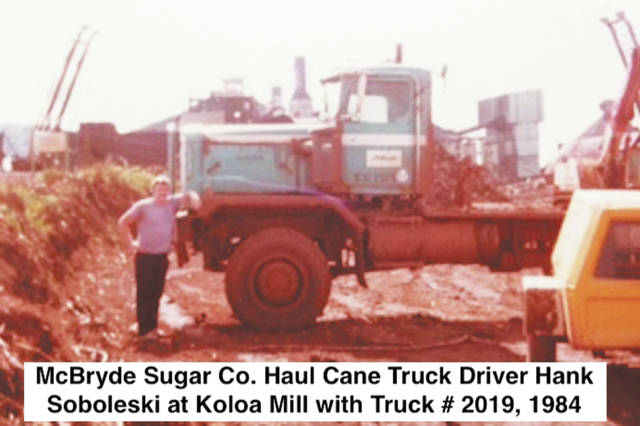During 1983 and 1984, I was employed by McBryde Sugar Co. as a haul cane truck driver, working rotating shifts around the clock on one of three harvesting gangs.
The gang I worked on was supervised by Cecilio Dacay and Cereal Fernandez and was nicknamed the “Visaya Gang,” since a number of its men were local Filipinos of Visayan ancestry.
My job, along with my fellow haul cane truck drivers, was to haul cane from McBryde fields — which extended along the southern portion of Kauai from Eleele to Mahaulepu — to the Koloa mill for processing.
Tractor and crane operators were also assigned to our gang.
After a harvest field had been burned to remove opala, big Caterpillar tractors would push the cane into windrows.
Haul cane trucks would then enter the field and proceed to the end of a windrow, where a crane would load cane into their chain-trailers — 40 tons plus each.
Meanwhile, smaller tractors with liliko rakes would push pieces of cane that had fallen around the crane into the windrow.
Our haul cane trucks, by the way, were equipped with Cummins diesel engines with as much as 400 hp and a single stick box with 10 forward gears, five front-wheel-drive gears and one reverse gear.
Pump 6, the name of an irrigation pump in Lawai Gulch, was also the place — steep and deep with a narrow bridge at the bottom — where McBryde’s main haul cane road crossed the gulch.
Haul cane trucks had crashed while descending Pump 6 when their drivers lost control, so it was imperative to proceed downhill at a speed one could handle.
Before descending, we’d downshift into a proper gear, and while driving down, we’d use engine and trailer brakes to prevent engine over revving caused by the enormous weight of the sugar cane pushing the truck downhill.
Near the bottom we’d upshift, increase speed, cross the bridge and then downshift as we ascended the gulch.
Hauling cane through the Haupu Range Tunnel at night was also a real eye-opener.


